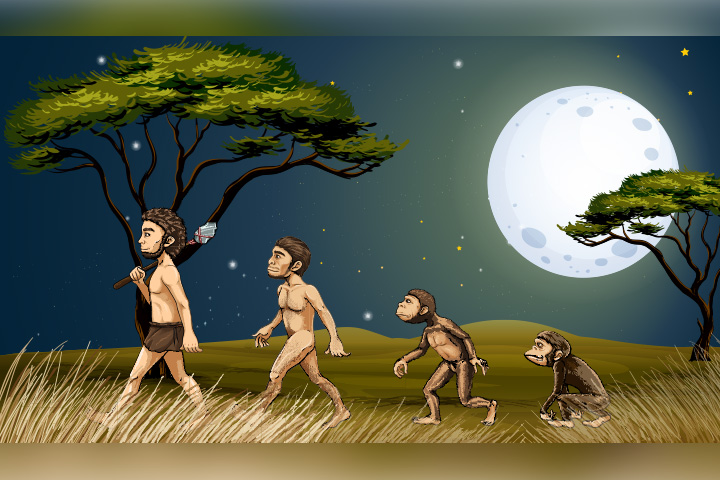Image: Shutterstock
When your child asks you questions such as “Where did birds come from?” or “How did humans come into being?” it may be a great idea to introduce the concept of evolution to them.
Children are often told that monkeys and humans shared a common ancestor. However, telling them this piece of information without explaining the theory of evolution only confuses young minds. A good way to approach the topic of evolution is by introducing them to Charles Darwin, the scientist and biologist who introduced the world to this theory.
Here is our guide on how to tackle the subject and enable children to understand Darwin and his theory of evolution. We also give you a few facts about evolution to pique their interest.
What Is Evolution?
The theory of evolution explains how all living organisms on our planet are related. Over a period of millions of years, organisms undergo many changes based upon their genes and surroundings.
Living organisms develop features to survive and adapt to their habitats. For example, birds and reptiles are related, but since birds needed to fly, their bodies became lighter, their bones hollow, and their teeth developed into beaks – all to enable them to fly (1) (2).
Darwin performed multiple experiments and studies on various organisms to confirm how all living organisms on Earth have a common ancestor. Let’s understand more about his theory of evolution (3).
Darwin’s Theory Of Evolution
Explaining evolution to kids is incomplete without mentioning what Darwin postulated in his book On the Origin of Species. Here are some simplified pieces of information about Darwin’s theory of evolution for children (4) (5).
- Charles Darwin is called the Father of Evolution, and he wrote all his findings in his book On the Origin of Species by Means of Natural Selection.
- He set out to travel on the British ship H.M.S. Beagle that took him to the Galapagos Islands on the South American coast, which were filled with a wide variety of plants and animals.
- He observed that there were different types of finches, a type of small bird, and tortoises.
- When he studied these animals closely, he noticed that they evolved or developed features to survive based on their needs. He termed this evolutionary process “natural selection.”
- According to Darwin, individual organisms adapt to their habitat, develop features, and pass them on to their offspring. This is how evolution takes place, making the new organism look similar to the ancestor but with evolved features.
An excellent way to teach children about natural selection is to explain how reptiles evolved into birds and apes evolved into humans. Tell children about the common characteristics that the two groups have and how they needed to evolve to survive in their new habitat.
Narrate the evolutionary story about Darwin’s finches, the small brown birds on the Galapagos islands. Darwin realized that there were different types of finches on the islands. All of the finches looked similar, but their beak shapes varied depending on the islands they were on. On close observation, Darwin realized that the finches’ beaks evolved or changed based on the availability of different kinds of foods on the islands they lived on.
For example, some finches had heavy beaks for eating tough nuts that grew on the island they lived on, others had sharp beaks as their primary source of food was cacti, and a few had long beaks that enabled them to pick up insects for food.
30 Evolution Facts For Children
With basic knowledge about who Darwin is and what he suggested, children will now be able to understand a few facts about evolution. Here are some fun facts on evolution that will open up tons of imaginative possibilities in your child’s mind (6) (7) (8) (9) (10) (11) (12).
- Although they may belong to the same species, no two animals are the same.
- Although dogs originated from wolves, there are over 340 breeds of dogs today.
- Fossils found worldwide are great evidence for evolution as they give us details about how organisms in the past centuries or millennia were like.
- Fossils also reveal that earlier animals were simpler than their recent relatives.
- Did you know that we share our five-finger structure on our feet and hands with animals that have paws, wings, and flippers, such as bats, lemurs, dogs, and cats?
- Even the slightest change in color or design of a plant or animal is a result of the organism’s attempt to survive and pass on the superior traits to its offspring to ensure continuity of the species.
- All organisms have evolved from single-celled bacteria that lived on Earth a few billion years ago.
- Did you know that dogs and seals have the same ancestor? It was due to the different habitats that they developed into different organisms.
- Cats and hyenas evolved from the same ancestor.
- Among reptiles, snakes and lizards have the same ancestor. We know this because some snakes today have hip bones that are also seen in lizards.
- Whales are mammals, and the presence of some small bones in dolphins and mammals indicate that their ancestors walked on land before living in the water.
- Birds evolved from reptiles—not just any reptiles but dinosaurs. In fact, the closest reptile relatives of the birds are crocodiles.
- Evolution does not follow a straight line. Imagine it to be a tree with multiple branches. Each branch gives rise to new branches. However, while some branches give rise to new branches, others may die off. This is how evolution works too—not all adaptations in an organism are successful.
- Organisms have an instinct that allows them to survive. This is the basis for migration, wherein birds move to warmer locations to survive harsh winters.
- Evolutionary changes do not occur immediately. They take thousands and millions of years to occur. So, we cannot see evolution happening in front of our eyes.
- Humans came into existence around 2.5 million years ago, and it took around 5 million years for this to happen.
- If you thought dinosaurs were the first or the oldest reptiles to walk on Earth, think again! Dinosaurs roamed the Earth 225 million years ago, but the oldest reptiles walked on Earth around 315 million years ago.
- The oldest known fossils are believed to be around 3.5 billion years old.
- Did you know human ancestors originated from the water?
- Evolutionary traits that are passed on from one generation to the next are governed by genes. Evolution is an interaction between the organism’s genes and its environment.
- Did you know that dolphins and sharks originated from different ancestors even though they are both water animals? While dolphins evolved from mammals, sharks originated from fishes.
- Since our ancestors had a tail, every human baby in the womb develops a tail in the initial stages, which eventually disappears as the baby develops.
- Humans did not evolve from monkeys or apes. In fact, humans, monkeys, apes, and other primates share a common ancestor!
- The phrase “survival of the fittest” was coined to explain that species that adapted the best to their changing environment were able to survive, while the others perished.
- It took Charles Darwin about 20 years to write and publish his book On the Origin of Species.
- Did you know that human evolution has influenced changes in other species and organisms too? For example, lice originally clung to hair. But, as humans began wearing clothes, body louse came about, which clung to clothing and not hair.
- The duck-billed platypus is one of the earliest mammals and is said to have developed from reptiles. It lays eggs like reptiles and produces milk like mammals. It can also produce venom like its reptilian ancestors.
- It is believed that goosebumps are a remnant of evolution and the remains of thick hair that covered our ancestors.
- Did you know that the island of Madagascar off the eastern coast of Africa does not have elephants, hippos, and giraffes? Well, this is because Madagascar split from Africa around 165 million years ago, and many new species of animals evolved on the island. However, some fossil records show that hippos lived on the island. These hippos were called pygmy hippos and were smaller than their African cousins.
- Humans have lesser body hair than other primates as it helps us lose heat faster. This is an evolutionary trait that has developed over a long period.
Some Books On Evolution for Children To Read
Here are some age-appropriate books that you can get for your child to acquaint them with the concept of evolution.
- On the Origin of Species by Sabina Radeva
- Who Was Charles Darwin? by Deborah Hopkinson
- Life on Earth by Steve Jenkins
- What Darwin Saw by Rosalyn Schanzer
- Charles Darwin and the Beagle Adventure by AJ Wood
- Our Family Tree by Lisa Westberg Peters
Evolution is an intriguing and exciting theory for people of all ages. Acquainting children with this theory early on can satiate their naturally curious young minds. We hope this post gives you enough information to answer all your child’s questions about evolution.


































